Development of Alkaline Reduced Water Using High-Temperature-Roasted Mineral Salt and Its Antioxidative Effect in RAW 264.7 Murine Macrophage Cell Line
Abstract
:1. Introduction
2. Materials and Methods
2.1. Experimental Materials
Mineral Contents and Properties of HtRMS
2.2. Experimental Design
2.3. Cell Culture and LPS Stimulation
2.4. Cell Culture and H2O2 Stimulation
2.5. Cell Proliferation Assay
2.6. ROS Assay
2.7. NO Assay
2.8. Endogenous Antioxidant Enzyme Activities
2.9. Ca2+ Assay
2.10. Western Blot Analysis
2.11. Data Management and Statistical Analysis
3. Results
3.1. Effect of HtRMS on H2O2- and LPS-Induced Cell Viability of Murine Macrophage RAW 264.7 Cells
3.2. Effect of HtRMS on OS Production of H2O2- and LPS-Induced Murine Macrophage RAW 264.7 Cells
3.3. Effect of HtRMS on Intracellular Antioxidant Enzyme Levels of H2O2- and LPS-Induced Murine Macrophage RAW 264.7 Cells
3.4. Effect of HtRMS on the Intracellular Ca2+ Level of H2O2- and LPS-Induced Murine Macrophage RAW 264.7 Cells
3.5. Effect of HtRMS on p-p38, p-JNK, and p-ERK of H2O2- and LPS-Induced Murine Macrophage RAW 264.7 Cells
4. Discussion
5. Conclusions
Author Contributions
Funding
Institutional Review Board Statement
Informed Consent Statement
Data Availability Statement
Acknowledgments
Conflicts of Interest
References
- Hussain, T.; Tan, B.; Yin, Y.; Blachier, F.; Tossou, M.C.B.; Rahu, N. Oxidative Stress and Inflammation: What Polyphenols Can Do for Us? Oxid. Med. Cell. Longev. 2016, 2016, 7432797. [Google Scholar] [CrossRef] [PubMed] [Green Version]
- Begum, R.; Kim, C.; Fadriquela, A.; Bajgai, J.; Jing, X.; Kim, D.-H.; Kim, S.-K.; Lee, K.-J. Molecular hydrogen protects against oxidative stress-induced RAW 264.7 macrophage cells through the activation of Nrf2 and inhibition of MAPK signaling pathway. Mol. Cell. Toxicol. 2020, 16, 103–118. [Google Scholar] [CrossRef]
- Rahman, H.; Bajgai, J.; Fadriquela, A.; Sharma, S.; Trinh, T.T.; Akter, R.; Jeong, Y.J.; Goh, S.H.; Kim, C.-S.; Lee, K.-J. Therapeutic Potential of Natural Products in Treating Neurodegenerative Disorders and Their Future Prospects and Challenges. Molecules 2021, 26, 5327. [Google Scholar] [CrossRef]
- Pizzino, G.; Irrera, N.; Cucinotta, M.; Pallio, G.; Mannino, F.; Arcoraci, V.; Squadrito, F.; Altavilla, D.; Bitto, A. Oxidative Stress: Harms and Benefits for Human Health. Oxid. Med. Cell. Longev. 2017, 2017, 8416763. [Google Scholar] [CrossRef]
- Park, J.; Min, J.-S.; Kim, B.; Chae, U.-B.; Yun, J.W.; Choi, M.-S.; Kong, I.-K.; Chang, K.-T.; Lee, D.-S. Mitochondrial ROS govern the LPS-induced pro-inflammatory response in microglia cells by regulating MAPK and NF-κB pathways. Neurosci. Lett. 2015, 584, 191–196. [Google Scholar] [CrossRef]
- Ransy, C.; Vaz, C.; Lombès, A.; Bouillaud, F. Use of H2O2 to Cause Oxidative Stress, the Catalase Issue. Int. J. Mol. Sci. 2020, 21, 9149. [Google Scholar] [CrossRef]
- Jeong, J.H.; Noh, M.-Y.; Choi, J.-H.; Lee, H.; Kim, S.H. Neuroprotective and antioxidant activities of bamboo salt soy sauce against H2O2-induced oxidative stress in rat cortical neurons. Exp. Ther. Med. 2016, 11, 1201–1210. [Google Scholar] [CrossRef] [PubMed] [Green Version]
- Kim, N.-R.; Nam, S.-Y.; Ryu, K.-J.; Kim, H.-M.; Jeong, H.-J. Effects of bamboo salt and its component, hydrogen sulfide, on enhancing immunity. Mol. Med. Rep. 2016, 14, 1673–1680. [Google Scholar] [CrossRef]
- Peng, H.-H.; Liu, Y.-J.; Ojcius, D.; Lee, C.-M.; Chen, R.-H.; Huang, P.-R.; Martel, J.; Young, J.D. Mineral particles stimulate innate immunity through neutrophil extracellular traps containing HMGB1. Sci. Rep. 2017, 7, 1–16. [Google Scholar] [CrossRef] [PubMed] [Green Version]
- Sokrateva, T.D.; Roussev, B.H.; Nashar, M.A.; Kiselova-Kaneva, Y.D.; Mihaylova, G.M.; Todorova, M.N.; Pasheva, M.G.; Tasinov, O.B.; Nazifova-Tasinova, N.F.; Vankova, D.G.; et al. Effects of sulphur-containing mineral water intake on oxidative status and markers for inflammation in healthy subjects. Arch. Physiol. Biochem. 2019, 127, 1–10. [Google Scholar] [CrossRef] [PubMed]
- Pehrsson, P.; Patterson, K.; Perry, C. The Mineral Content of Us Drinking and Municipal Water. In Proceedings of the 32nd National Nutrient Databank Conference, Ottawa, ON, Canada, 12–14 May 2008; pp. 12–14. [Google Scholar]
- Huang, L. Molecular hydrogen: A therapeutic antioxidant and beyond. Med. Gas Res. 2016, 6, 219–222. [Google Scholar] [CrossRef] [PubMed] [Green Version]
- Ohta, S. Molecular Hydrogen as a Novel Antioxidant. Methods Enzymol. 2015, 555, 289–317. [Google Scholar] [CrossRef] [PubMed]
- Ichihara, M.; Sobue, S.; Ito, M.; Ito, M.; Hirayama, M.; Ohno, K. Beneficial biological effects and the underlying mechanisms of molecular hydrogen—Comprehensive review of 321 original articles. Med. Gas Res. 2015, 5, 1–21. [Google Scholar] [CrossRef] [PubMed] [Green Version]
- Ku, J.Y.; Park, M.J.; Park, H.J.; Park, N.C.; Joo, B.S. Combination of Korean Red Ginseng Extract and Hydrogen-Rich Water Improves Spermatogenesis and Sperm Motility in Male Mice. Chin. J. Integr. Med. 2020, 26, 361–369. [Google Scholar] [CrossRef] [PubMed]
- Ohsawa, I.; Ishikawa, M.; Takahashi, K.; Watanabe, M.; Nishimaki, K.; Yamagata, K.; Katsura, K.-I.; Katayama, Y.; Asoh, S.; Ohta, S. Hydrogen acts as a therapeutic antioxidant by selectively reducing cytotoxic oxygen radicals. Nat. Med. 2007, 13, 688–694. [Google Scholar] [CrossRef]
- Kurokawa, R.; Seo, T.; Sato, B.; Hirano, S.-I.; Sato, F. Convenient methods for ingestion of molecular hydrogen: Drinking, injection, and inhalation. Med. Gas Res. 2015, 5, 13. [Google Scholar] [CrossRef] [Green Version]
- Rias, Y.A.; Kurniawan, A.L.; Chang, C.W.; Gordon, C.J.; Tsai, H.T. Synergistic Effects of Regular Walking and Alkaline Electrolyzed Water on Decreasing Inflammation and Oxidative Stress, and Increasing Quality of Life in Individuals with Type 2 Diabetes: A Community Based Randomized Controlled Trial. Antioxidants 2020, 9, 946. [Google Scholar] [CrossRef]
- Yan, P.; Daliri, E.B.-M.; Oh, D.-H. New Clinical Applications of Electrolyzed Water: A Review. Microorganisms 2021, 9, 136. [Google Scholar] [CrossRef]
- Gordon, S. The macrophage: Past, present and future. Eur. J. Immunol. 2007, 37, S9–S17. [Google Scholar] [CrossRef]
- Roux, P.P.; Blenis, J. ERK and p38 MAPK-Activated Protein Kinases: A Family of Protein Kinases with Diverse Biological Functions. Microbiol. Mol. Biol. Rev. 2004, 68, 320–344. [Google Scholar] [CrossRef] [Green Version]
- Cargnello, M.; Roux, P.P. Activation and Function of the MAPKs and Their Substrates, the MAPK-Activated Protein Kinases. Microbiol. Mol. Biol. Rev. 2011, 75, 50–83. [Google Scholar] [CrossRef] [Green Version]
- Zhao, X. Anticancer and Antiinflammatory Effects of Bamboo Salt. Available online: http://www.bookpi.org/bookstore/product/anticancer-and-antiinflammatory-effects-of-bamboo-salt/ (accessed on 1 September 2021).
- Qian, Y.; Zhao, X. Alkaline properties and antioxidant activities of bamboo salt. China Condiment 2014, 39, 28–46. [Google Scholar]
- Chen, J.; Wu, Y.; Sun, Y.; Dong, X.; Wang, Z.; Zhang, Z.; Xiao, Y.; Dong, G. Bacterial Lipopolysaccharide Induced Alterations of Genome-Wide DNA Methylation and Promoter Methylation of Lactation-Related Genes in Bovine Mammary Epithelial Cells. Toxins 2019, 11, 298. [Google Scholar] [CrossRef] [Green Version]
- Rendra, E.; Riabov, V.; Mossel, D.M.; Sevastyanova, T.; Harmsen, M.C.; Kzhyshkowska, J. Reactive oxygen species (ROS) in macrophage activation and function in diabetes. Immunobiology 2019, 224, 242–253. [Google Scholar] [CrossRef] [PubMed]
- Covarrubias, A.J.; Byles, V.; Horng, T. ROS sets the stage for macrophage differentiation. Cell Res. 2013, 23, 984–985. [Google Scholar] [CrossRef] [Green Version]
- Zhang, Y.; Choksi, S.; Chen, K.; Pobezinskaya, Y.; Linnoila, I.; Liu, Z.-G. ROS play a critical role in the differentiation of alternatively activated macrophages and the occurrence of tumor-associated macrophages. Cell Res. 2013, 23, 898–914. [Google Scholar] [CrossRef] [PubMed] [Green Version]
- Forman, H.J. Redox signaling in macrophages. Mol. Asp. Med. 2001, 22, 189–216. [Google Scholar] [CrossRef]
- Denis, M. Human monocytes/macrophages: NO or no NO? J. Leukoc. Biol. 1994, 55, 682–684. [Google Scholar] [CrossRef]
- Zagury, D.; Le Buanec, H.; Bizzini, B.; Burny, A.; Lewis, G.; Gallo, R. Active versus passive anti-cytokine antibody therapy against cytokine-associated chronic diseases. Cytokine Growth Factor Rev. 2003, 14, 123–137. [Google Scholar] [CrossRef]
- Pierini, D.; Bryan, N.S. Nitric oxide availability as a marker of oxidative stress. In Advanced Protocols in Oxidative Stress III. Methods in Molecular Biology (Methods and Protocols); Armstrong, D., Ed.; Humana Press: New York, NY, USA, 2015; Volume 1208, pp. 63–71. [Google Scholar]
- Ohta, S. Molecular hydrogen is a novel antioxidant to efficiently reduce oxidative stress with potential for the improvement of mitochondrial diseases. Biochim. Biophys. Acta Gen. Subj. 2012, 1820, 586–594. [Google Scholar] [CrossRef]
- Park, S.-K.; Park, S.-K. Electrolyzed-reduced water increases resistance to oxidative stress, fertility, and lifespan via insulin/IGF-1-like signal in C. elegans. Biol. Res. 2013, 46, 147–152. [Google Scholar] [CrossRef] [PubMed] [Green Version]
- Terasaki, Y.; Ohsawa, I.; Terasaki, M.; Takahashi, M.; Kunugi, S.; Dedong, K.; Urushiyama, H.; Amenomori, S.; Kaneko-Togashi, M.; Kuwahara, N.; et al. Hydrogen therapy attenuates irradiation-induced lung damage by reducing oxidative stress. Am. J. Physiol. Cell. Mol. Physiol. 2011, 301, L415–L426. [Google Scholar] [CrossRef] [PubMed] [Green Version]
- Jeon, G.; Kim, C.; Cho, U.M.; Hwang, E.T.; Hwang, H.S.; Min, J. Melanin-Decolorizing Activity of Antioxidant Enzymes, Glutathione Peroxidase, Thiol Peroxidase, and Catalase. Mol. Biotechnol. 2021, 63, 150–155. [Google Scholar] [CrossRef] [PubMed]
- Traber, M.G.; Packer, L. Vitamin E: Beyond antioxidant function. Am. J. Clin. Nutr. 1995, 62, 1501S–1509S. [Google Scholar] [CrossRef] [Green Version]
- Meng, R.; Wu, Z.; Xie, Q.-T.; Cheng, J.-S.; Zhang, B. Preparation and characterization of zein/carboxymethyl dextrin nanoparticles to encapsulate curcumin: Physicochemical stability, antioxidant activity and controlled release properties. Food Chem. 2021, 340, 127893. [Google Scholar] [CrossRef] [PubMed]
- Ridwan, R.D.; Tantiana, T.; Setijanto, D.; Kusuma, A.K.; Putranto, A.F. Kronik Periodontitli Wistar Sıçan (Rattus Novergicus)’larda Elektrolize İndirgenmiş Suyun Antioksidan ve Antiinflamatuvar Etkisi. Kafkas Univ. Veter Fak. Derg. 2019, 25, 539–544. [Google Scholar] [CrossRef]
- Hu, D.; Li, D.; Shigeta, M.; Ochi, Y.; Okauchi, T.; Neyama, H.; Kabayama, S.; Watanabe, Y.; Cui, Y. Alleviation of the chronic stress response attributed to the antioxidant and anti-inflammatory effects of electrolyzed hydrogen water. Biochem. Biophys. Res. Commun. 2021, 535, 1–5. [Google Scholar] [CrossRef] [PubMed]
- Lin, C.-P.; Chuang, W.-C.; Lu, F.-J.; Chen, C.-Y. Anti-oxidant and anti-inflammatory effects of hydrogen-rich water alleviate ethanol-induced fatty liver in mice. World J. Gastroenterol. 2017, 23, 4920–4934. [Google Scholar] [CrossRef] [PubMed]
- Ishibashi, T. Molecular Hydrogen: New Antioxidant and Anti-inflammatory Therapy for Rheumatoid Arthritis and Related Diseases. Curr. Pharm. Des. 2013, 19, 6375–6381. [Google Scholar] [CrossRef] [PubMed] [Green Version]
- Bagur, R.; Hajnóczky, G. Intracellular Ca2+ Sensing: Its Role in Calcium Homeostasis and Signaling. Mol. Cell 2017, 66, 780–788. [Google Scholar] [CrossRef] [Green Version]
- Wright, M.F.; Bowdridge, E.; McDermott, E.L.; Richardson, S.; Scheidler, J.; Syed, Q.; Bush, T.; Inskeep, E.K.; Flores, J.A. Mechanisms of Intracellular Calcium Homeostasis in Developing and Mature Bovine Corpora Lutea1. Biol. Reprod. 2014, 90, 55. [Google Scholar] [CrossRef] [PubMed] [Green Version]
- Chuderland, D.; Seger, R. Calcium regulates ERK signaling by modulating its protein-protein interactions. Commun. Integr. Biol. 2008, 1, 4–5. [Google Scholar] [CrossRef] [PubMed] [Green Version]
- Phong, M.S.; Van Horn, R.D.; Li, S.; Tucker-Kellogg, G.; Surana, U.; Ye, X.S. p38 Mitogen-Activated Protein Kinase Promotes Cell Survival in Response to DNA Damage but Is Not Required for the G 2 DNA Damage Checkpoint in Human Cancer Cells. Mol. Cell. Biol. 2010, 30, 3816–3826. [Google Scholar] [CrossRef] [PubMed] [Green Version]
- Mebratu, Y.; Tesfaigzi, Y. How ERK1/2 activation controls cell proliferation and cell death: Is subcellular localization the answer? Cell Cycle 2009, 8, 1168–1175. [Google Scholar] [CrossRef]
- Gururajan, M.; Chui, R.; Karuppannan, A.K.; Ke, J.; Jennings, C.D.; Bondada, S. c-Jun N-terminal kinase (JNK) is required for survival and proliferation of B-lymphoma cells. Blood 2005, 106, 1382–1391. [Google Scholar] [CrossRef] [Green Version]
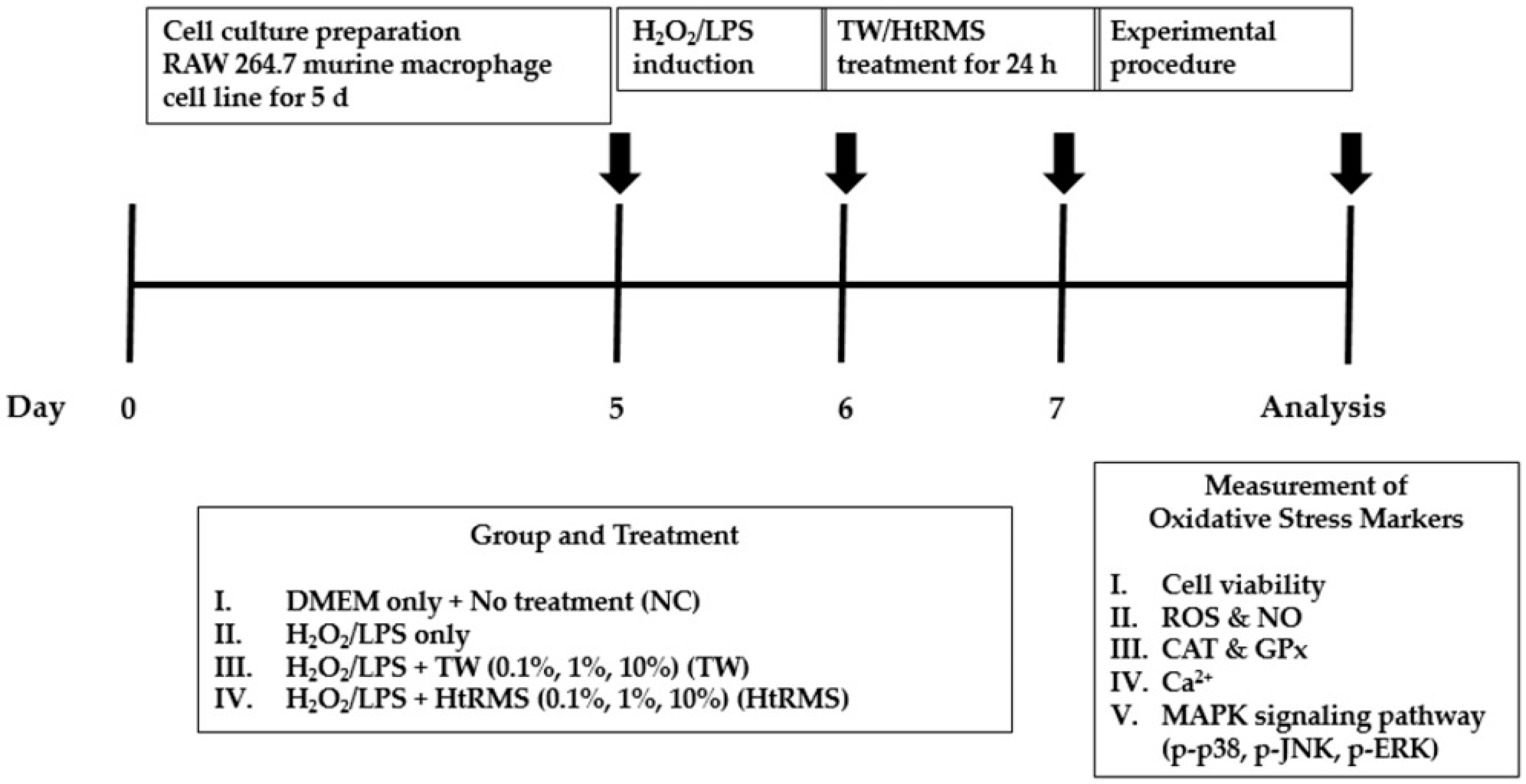

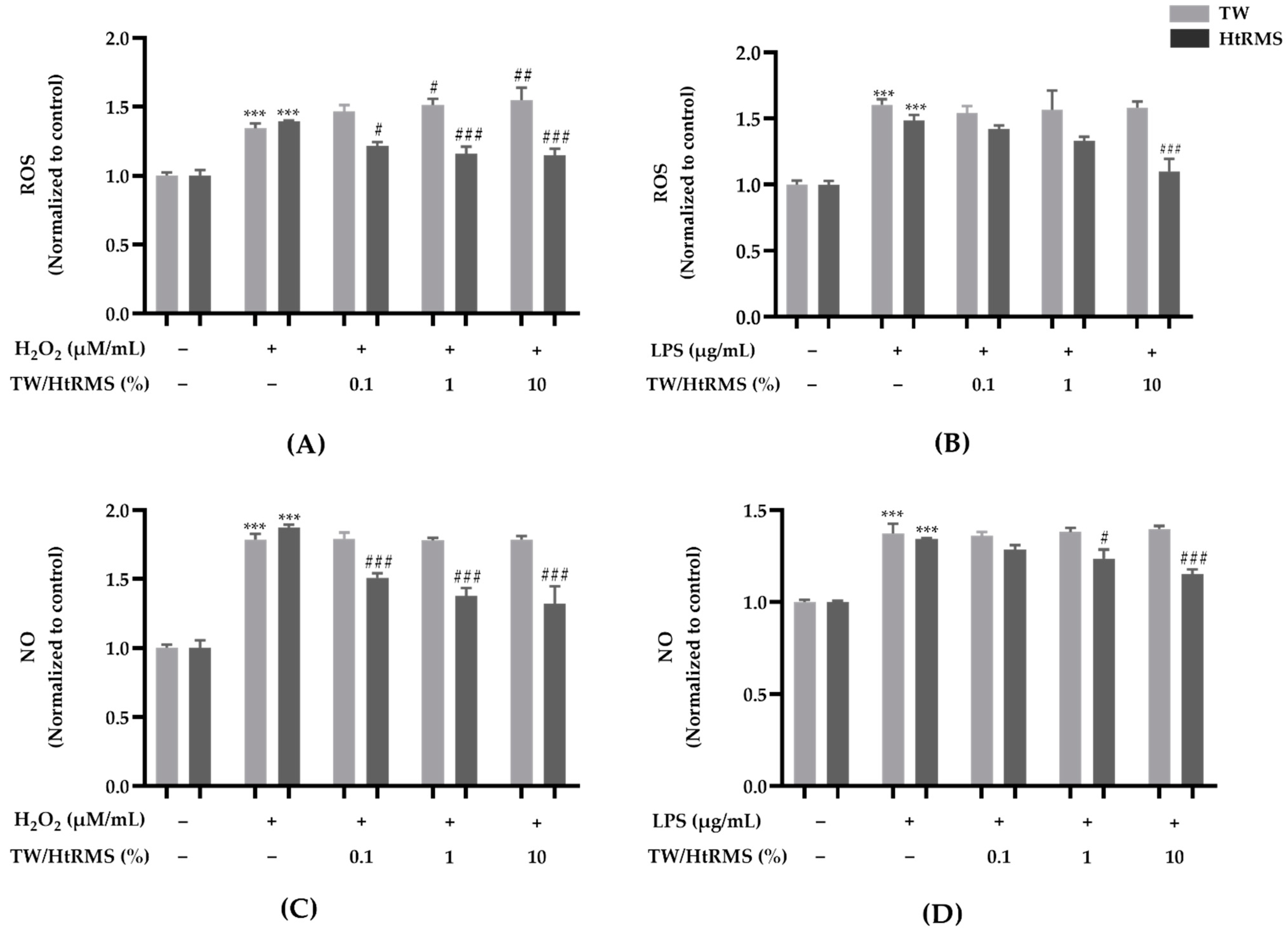
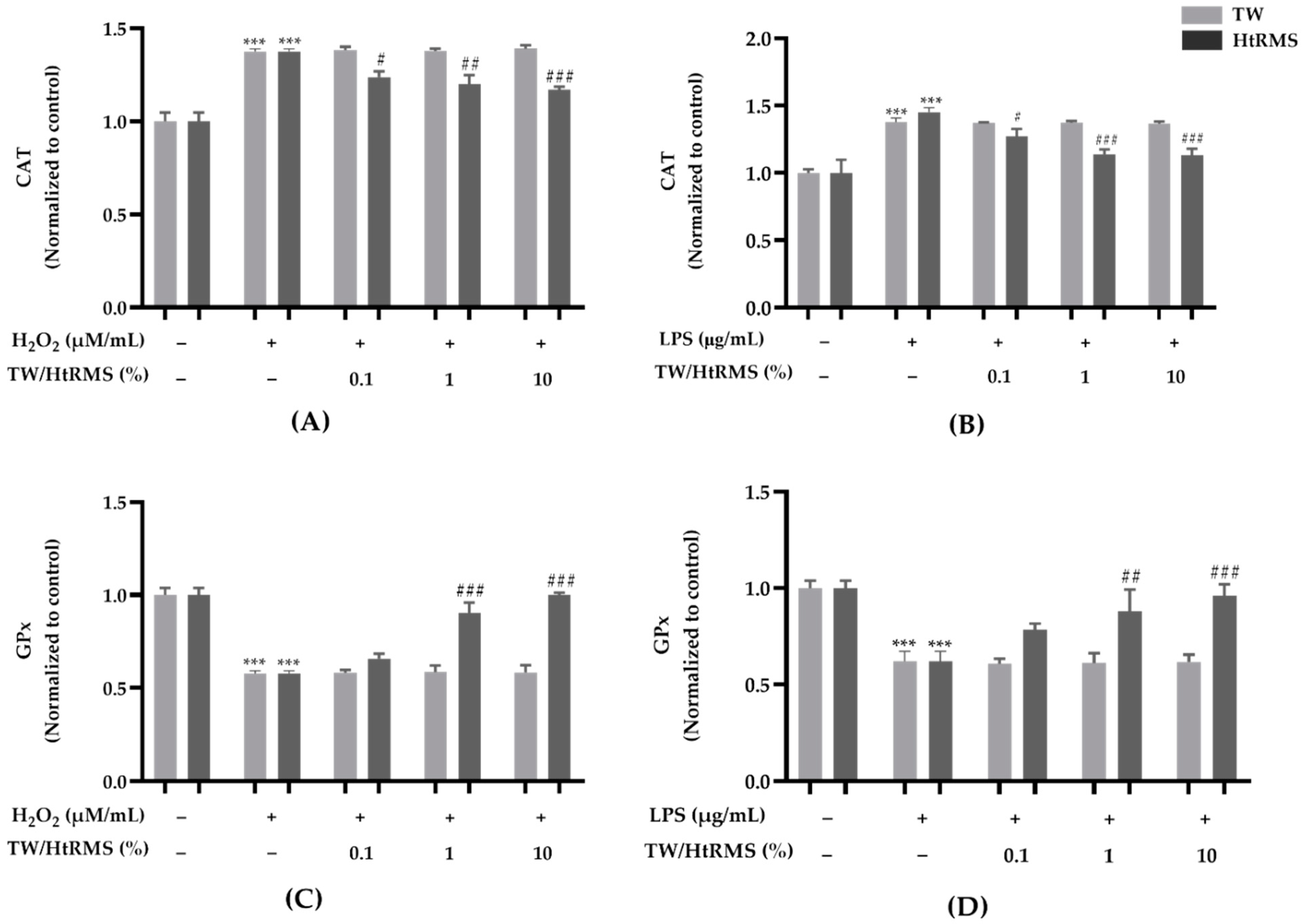
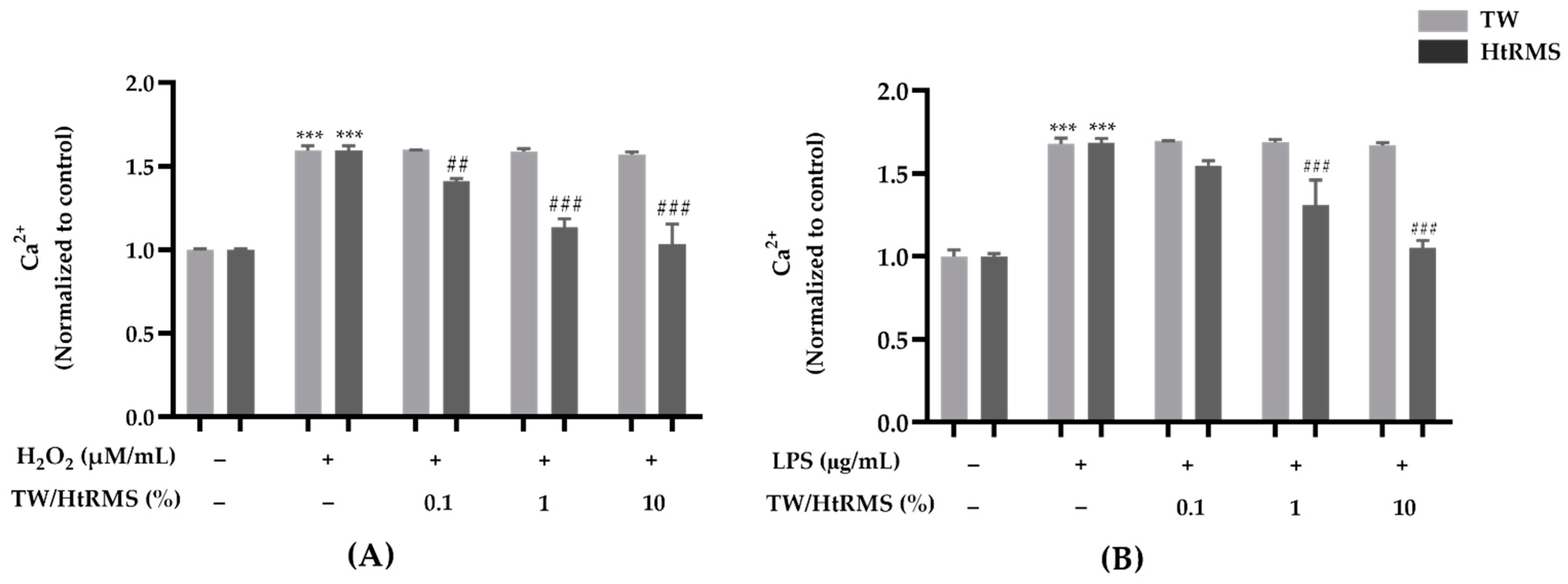
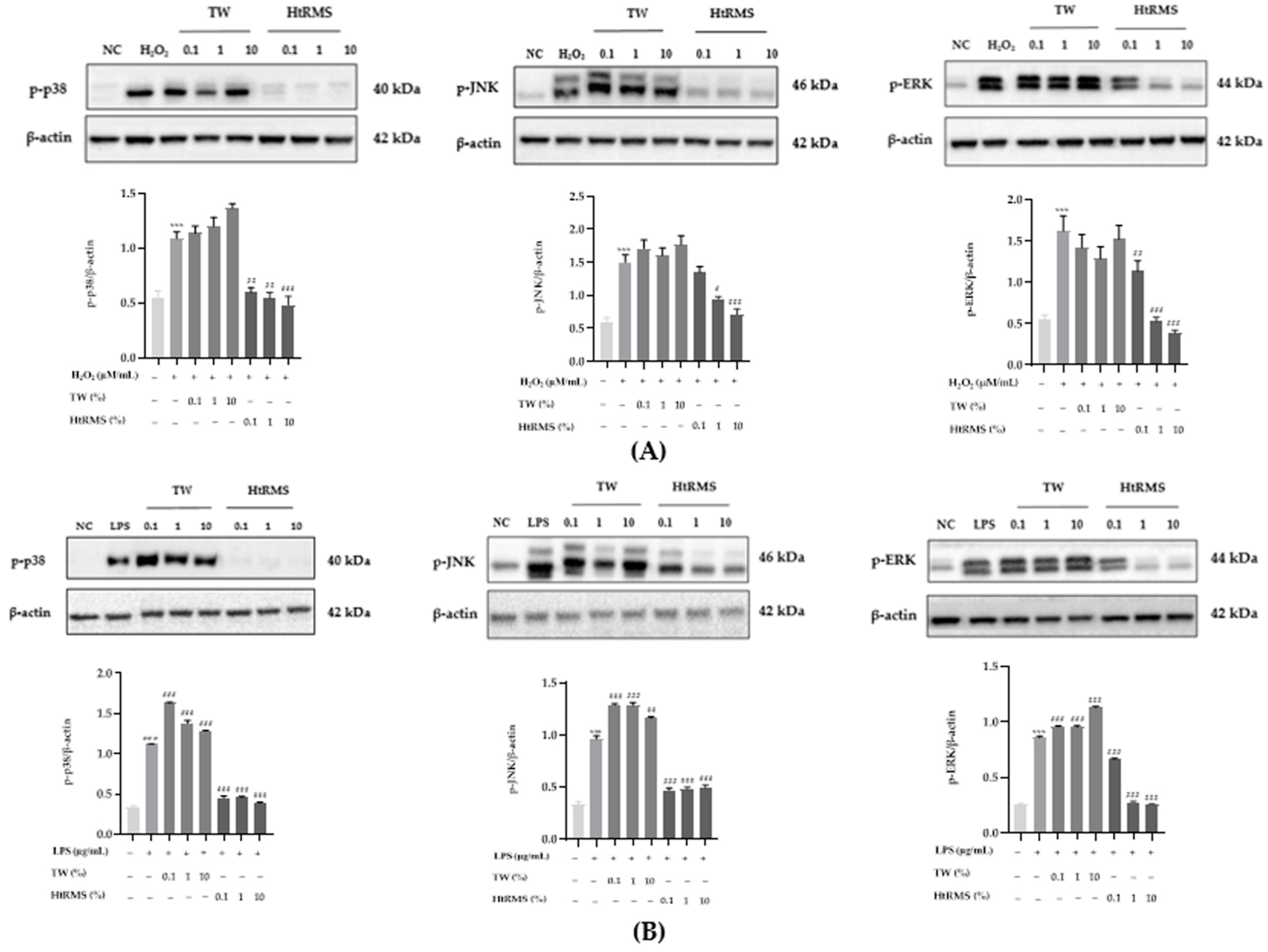
| Mineral Components | Contents (ppm) | Mineral Components | Contents (ppm) |
|---|---|---|---|
| Calcium (Ca2+) | 1722 | Copper (Cu2+) | 2.28 |
| Phosphorous (P3−) | 122 | Barium (Ba2+) | 6.46 |
| Potassium (K+) | 1738 | Tin (Sn4+) | 1.24 |
| Sulfur (S2−) | 4220 | Iodine (I−) | 67 |
| Sodium (Na+) | 379,400 | Titanium (Ti3+) | 2.6 |
| Chlorine (Cl−) | 569,600 | Boron (B3+) | 18.2 |
| Magnesium (Mg2+) | 746 | Selenium (Se2−) | 3.01 |
| Ion (Fe2+) | 26.2 | Lithium (Li+) | 14.2 |
| Fluorine (F−) | 18 | Molybdenum (Mo2+) | 1.95 |
| Zinc (Zn2+) | 3.57 | Gallium (Ga3+) | 10.36 |
| Silicon (Si4+) | 45.6 | Vanadium (V−) | 9.73 |
| Rubidium (Rb+) | 6.27 | Beryllium (Be2+) | 14.2 |
| Strontium (Sr+) | 67.8 | Bromine (Br−) | 8 |
| Materials | pH | ORP (mV) | TDS (ppm) | H2 (ppb) |
|---|---|---|---|---|
| TW | 7.32 | 609 | 105 | 0 |
| HtRMS | 10.5 | −380 | 27,000 | 450 |
Publisher’s Note: MDPI stays neutral with regard to jurisdictional claims in published maps and institutional affiliations. |
© 2021 by the authors. Licensee MDPI, Basel, Switzerland. This article is an open access article distributed under the terms and conditions of the Creative Commons Attribution (CC BY) license (https://creativecommons.org/licenses/by/4.0/).
Share and Cite
Trinh, T.T.; Fadriquela, A.; Lee, K.-J.; Bajgai, J.; Sharma, S.; Rahman, M.H.; Kim, C.-S.; Youn, S.-H.; Jeon, H.-T. Development of Alkaline Reduced Water Using High-Temperature-Roasted Mineral Salt and Its Antioxidative Effect in RAW 264.7 Murine Macrophage Cell Line. Processes 2021, 9, 1928. https://doi.org/10.3390/pr9111928
Trinh TT, Fadriquela A, Lee K-J, Bajgai J, Sharma S, Rahman MH, Kim C-S, Youn S-H, Jeon H-T. Development of Alkaline Reduced Water Using High-Temperature-Roasted Mineral Salt and Its Antioxidative Effect in RAW 264.7 Murine Macrophage Cell Line. Processes. 2021; 9(11):1928. https://doi.org/10.3390/pr9111928
Chicago/Turabian StyleTrinh, Thuy Thi, Ailyn Fadriquela, Kyu-Jae Lee, Johny Bajgai, Subham Sharma, Md. Habibur Rahman, Cheol-Su Kim, Sang-Hum Youn, and Hyoung-Tag Jeon. 2021. "Development of Alkaline Reduced Water Using High-Temperature-Roasted Mineral Salt and Its Antioxidative Effect in RAW 264.7 Murine Macrophage Cell Line" Processes 9, no. 11: 1928. https://doi.org/10.3390/pr9111928
APA StyleTrinh, T. T., Fadriquela, A., Lee, K.-J., Bajgai, J., Sharma, S., Rahman, M. H., Kim, C.-S., Youn, S.-H., & Jeon, H.-T. (2021). Development of Alkaline Reduced Water Using High-Temperature-Roasted Mineral Salt and Its Antioxidative Effect in RAW 264.7 Murine Macrophage Cell Line. Processes, 9(11), 1928. https://doi.org/10.3390/pr9111928








